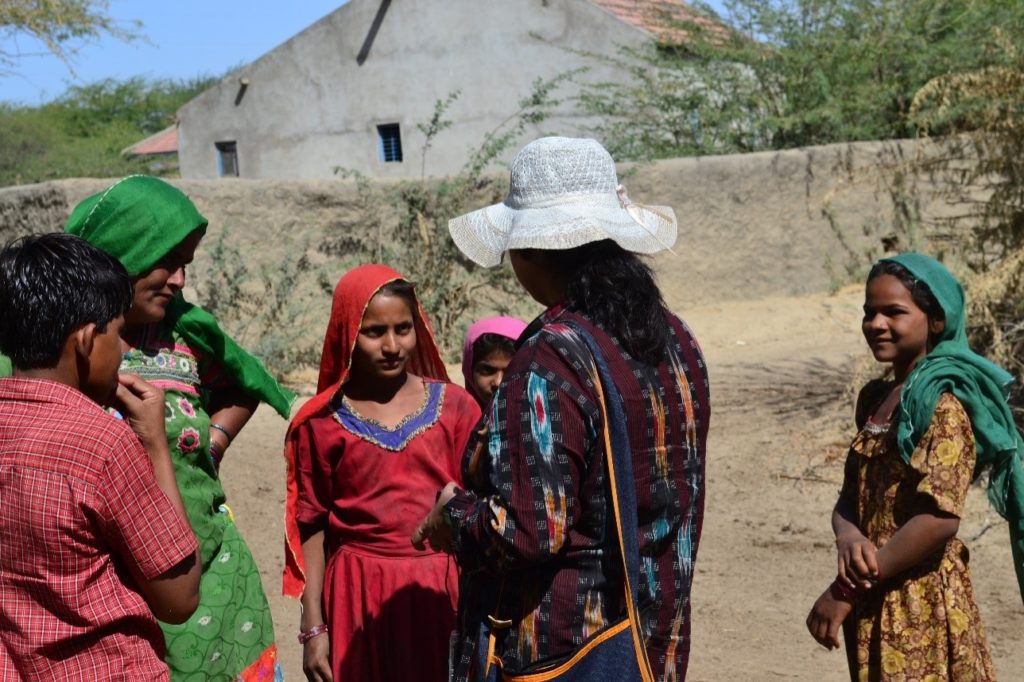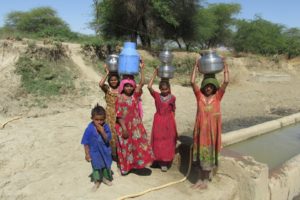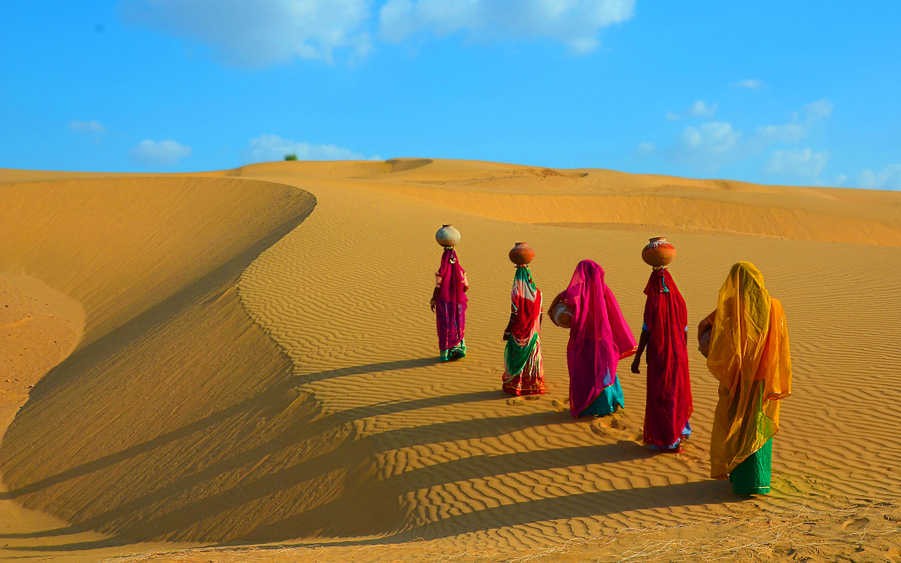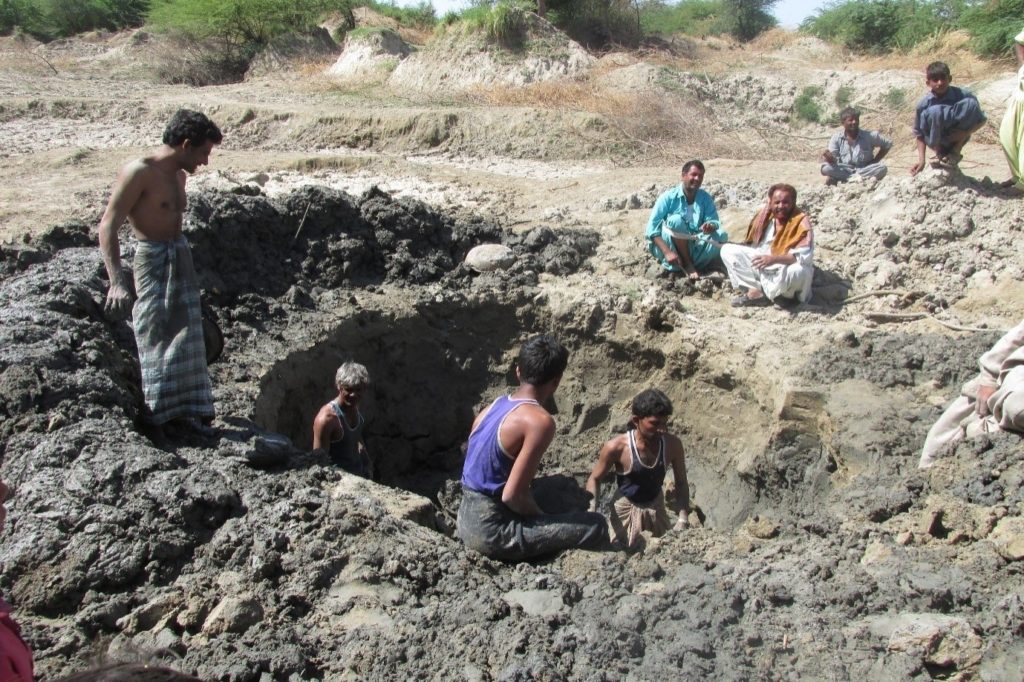“Every field has a Eucalyptus tree. If it over blooms, it is indicative of the fact that there will be sufficient rainfall“, a farmer in Kothasanamota, in his 60s, explained.
“Similarly, by watching the small black ‘chakli’ (Indian Robin/sparrow), we can estimate the occurrence of drought. If their black colour turns blue, it means drought is coming. Changing colours is common in chaklis, especially during impending droughts. Also, if they sit on empty branches, it is believed to be a drought year,”
Droughts are initiated due to changes in precipitation patterns and a reduction in the precipitation amount, resulting in a sudden and acute deficiency of soil moisture as well as surface-water and groundwater resources. However, this is more of a generalised description. In practice, droughts are a protean phenomenon. They manifest a number of conflicting characteristics that resist any attempt to reduce them to a singular category. For instance, meteorological drought is a result of inadequate rainfall and the deficiency of soil moisture which, in turn, leads to vegetative drought. When this influences the groundwater level and the minimum availability of groundwater reaches below average level, it leads to hydrological drought. Intense, continuous, or frequent meteorological and hydrological droughts cut the supply of moisture to plants, leading to vegetative and agricultural droughts. Recurrent agricultural droughts not only cause huge economic loss for the country but also flare up the price of food grains and other essential goods and commodities, triggering mass migration, poverty, exploitation of women and suicide. All of these result in a vicious cycle of damage to every sphere of life.
In this context, risk perception influences the mitigation of the problem. Faulty perception could result in time and money wasted in mitigation and preparation of a risk that threatens them to a greater degree. People respond to the way they process the information about a hazard. Often, it has been observed that a flawed perception can lead to untimely reactions leading to greater loss.
A period of water scarcity assumes a new meaning for farmers of different villages of Gujarat, though chiefly identified in local language as ‘Dushkal’ or ‘Dukal’. This blanket term perhaps encompasses what a drought may mean for these farmers, a ‘bad’ time, a period of infertility and dearth.
In this article, we will be looking at how people respond to the changing climate particularly in an agriculture-based state such as Gujarat, in the northern districts which are hit by droughts every 3-5 years in a 10-year period. Narratives collected from people in the course of field research helped us explore the range of responses to scarcity situations and the changing nature of water resources in nine villages of Gujarat. The different villages were:
- Upalagoda in Amirgadh Taluka of Banaskantha
- Kothasanamota of Satlasana Taluka in semi-arid Mehsana
- Nanakantharia and Laxmanpura in semi-arid Bhiloda Taluka of Sabarkantha
- Idata in arid Tharad
- Lodhrani in arid Vav in Banaskantha district
- Lodai,Berdo and Dhrang in the severely arid Kutch
All these study areas were highly drought-prone, where temperature and rainfall played a major factor, contributing to regular occurrences of drought and depleting the underground water table. Kutch also suffered from problems arising out of salinization.
Narratives from the Field:

Rooted in the traditions of the region, women in Gujarat do not speak up in front of elderly men. So, when we approached them, the women of the village were surprised to find that they were also being interviewed for the study, that their opinions were important and would have some influence on our research or, at a higher level, even policy-making.
For the purpose of this study, we interviewed a number of farmers from the region. Qualitative, in-depth interviews typically are much more like conversations than formal events with predetermined response categories. The researcher explores a few general topics to help uncover the participant’s views but otherwise respects how the participant frames and structures the responses. The interviews session with the people of the village helped us gain a lot of information about their lifestyle, their response to drought and their mitigation strategies. A thorough group discussion was held with the patwari, mamlatdar and the teacher of the village and this helped us rope in a lot of information about the village. They gave us a lot of extra information about the programmes and policies run by the government and also the impact of the drought on the lives of the people.
Our field study was based on an analysis of the interviews of both male and female respondents during group discussions. The interview was based on the principles of confidentiality and anonymity and only one interpreter was present as the language was alien to the researcher. Gender became the key variable in our interviews in that we approached men and women differently. The idea was also that the experiences and perceptions of women would be different from those of men and that they may not feel comfortable in sharing their versions in front of men. The decision to interview men and women separately was thus taken also keeping in view that such isolations may encourage women to speak.
Perception about Climate Change: Meaning, Identification, Causes and Occurrence
According to Paul Slovic, Baruach Fischhoff and Sarah Lichtenstein, “People respond to the hazard they perceive.” Thus, people do not respond to hazards that they do not perceive. Since risk is a possibility, its parameters are defined by the guesswork or the perception of risk by the individual. Overcoming the factor of risk depends upon how well the individual or group evaluates the possibilities and predicts the consequences of the negative outcome.
Giving the Hazard a Name:
Different farmers defined ‘drought’ differently. For farmers of Kothasanamota in Mehsana, the lack of rainfall or the excess of it, both signify drought. “Drought, to us, means a lack of rainfall as well as an excess of it. In both cases we suffer crop loss. If there is excess rain and crop loss because of it, we call it green drought,” a local farmer from among a group of about 20, explained. This is an instance of meteorological drought leading to vegetative drought.
In Lodai village in Kutch, people like to keep things simple. “If there is no water, then there is drought. If there is water in the well, we know that there is no drought,” explained a farmer. This is an instance of hydrological drought.
“Rainfall is in the hands of almighty,” an old farmer in Sabarkantha’s Nanakantharia village declared. “If there is no rainfall, there is drought. If there is rainfall, there is no drought.” Overhearing the discussion from a few metres away, a middle-aged mother of two put in her take: “Drought is when there is a heat wave.” This is another instance of a meteorological drought. A few more female farmers of the village elaborated on what they perceived as drought. “When there is less water for drinking and irrigation in bore wells and hand pumps, we get to know that there will be a drought”. This, again, is a hydrological drought.
Photo showing people digging the soil in search of water at Kutch
Identification
Much like the meaning of drought, its identification, too, has various parameters, relying heavily on villagers’ accrued knowledge through the years.
The prognosis of drought can be made through a host of traditional hints such as the state of the trees, the direction of the wind, animal mannerisms, and the like.
Another potential indicator of drought is the water level of the wells, farmers said. “Water can be found till 115 feet, beyond which there is granite, which doesn’t let water percolate. The water level has gone down some 300-400 metres in the last 25 years. Before that, the drop in level used to be 20-25 metres. Off late, the level is dropping 20-25 metres every year, and if this continues, it will create problem for drinking, irrigation and everything related to it. Typically, if the well is 120-125 feet deep, only then there is water in the current scenario,” a local farmer observed.
A woman who has been living in Nanakantharia village of Sabarkantha for almost 22 years now, since her marriage recalled that there was severe drought after 1992. Drought is when there is a heat wave, when the “paan” trees shed their leaves”, we know there will be a drought in 15-20 days. An old man in the same village added, “The trees shed their leaves, we can understand”. Another woman in the same village had a different view. According to her, it was easy to tell a drought year after a moist spell in the previous year, but in case of consecutive dry years, it was not easy to localise the drought.
She said, “How will we know if there’s going to be a drought? If it stretches across two consecutive years, we can hardly differentiate between a drought year and a regular one, as it is almost the same as last year.
We can only tell it apart when there is a period of dry spell after a moist year. All the livestock died, 25 years ago – we could not understand that it will be a drought that year.”
In all the villages that were surveyed, there was this consensus that the climate had changed but there was limited understanding as to why it had changed. The common refrain was: ‘Prakruti ki baathai’. They mostly held nature responsible for all their misfortune.

Photo showing Girls carrying water for household from the canal where water is available
Perceiving the Causes:
Responding to questions, the majority of the farmers and local people pointed at a scarcity of water both for drinking and for agriculture; a fall in the depth of water in the wells, the loss of crops, and unemployment as indicators of the onset of drought.
For the people of Laxmanpura, the over-extraction of water by rich farmers following the Green Revolution is what probably caused the depletion of the ground water table. According to one of the farmers, “Previously, there used to be a well which had water throughout the year even in severe dry conditions. It was used later for irrigating the crops during drought season fearing crop losses”. It was made even more deep by the rich people.
“There was only 50 ft-60 ft water in that well then, so they (the rich people of the village) made it deeper. They used to have jobs, they had money, so they made it deeper. We knew that once it became deeper, there woukd be more extraction and ultimately no water would be left for consumption.”
According to another farmer, lower rainfall is the reason for the shortage of water. Some attributed it to the increased use of water in agriculture which was never the case earlier. Water was only used for drinking and household purposes. “There is more use in agriculture now. Earlier, no one used to practise agriculture, there was no water for drinking either, now they need water for agriculture.”
In Mehsana, the use of ground water in agriculture was possible only after the village got an electricity connection. According to an old farmer, rich people are extracting more groundwater now, leaving the poor farmers vulnerable and affecting the groundwater levels. He said, “In the past, they procured drinking water from hand pumps. Now more water is used for agriculture because of this two-phase electricity.” The two-phase electricity helps them power the pumps, which, in turn, extracts ground water. There is no control of its use. Those who have money extract as much water as they can since they can pay for the electricity or buy diesel driven pumps. Water levels have gone down because of that. There is very little drinking water and not much water for irrigation left for the people.
Deforestation was cited as another reason for such changes in weather conditions. Forests aid in precipitation. They have cut down forests. There is no industry around yet, deforestation does affect the situation. The farmers say bleakly, “asar to padta hai.” There are very few trees left now. Every villager is responsible for this. If someone protests, no one cooperates with them, no one joins them in the protest. The person felling the tree doesn’t pay heed to the protest. The government, nonetheless, has taken some initiative to plant new saplings. But the fact remains that people are felling trees recklessly right in front of the villagers who hardly raise a voice.
Droughts of the Past
The way the villagers experienced the drought and the way it impacted their lives varied from area to area and the occurrence and intensity of droughts were not the same across all the study areas owing to their differing geographical settings. Their experiences varied according to age, class, caste, gender and their socio-economic position in the society which made them either very vulnerable or less so in coping with droughts.
In Palanpur, according to the knowledge and the experiences of the locals, drought was observed or experienced by them in the years 1978, 1943 and in 1956. According to one of the participants, drought was observed 35 years earlier when no crops could be grown and all of their livestock died. The villagers went out of the village, some 50-60 kms beyond its borders to work as labourers for at least 6-8 months. They used to bring food back to their families, feed them after coming home from work every two or three days. Then they used to go back again.
Another participant, aged approximately 60 to 65 years, mentioned a drought in 1943. He also recalled that in his lifetime ( he was 75 years old now), he had seen 6 to 7 separate drought occurrences. In those periods, they sold dry wood, livestock and bamboo at 10 paisa per piece to Palanpur. But according to him, drought years wouldn’t follow each other the way they do now. There would be years with adequate rainfall in between.
In 1956, as another villager recalled, over 200 cows, goats and buffaloes were killed by a drought. There was only one well beside the river which had not dried up. Otherwise everything had dried up.
In the village of Laxmanpura, the memory of the droughts of 1987 and 2005 is still very fresh. A woman recalled, “Everyone remembers the drought of 1987 when all our livestock died and men migrated to other areas”. Ten years ago, in 2005 there was a drought event that was also very bad. When I married into this village, I discovered that there was no water for everyday use, no water for irrigation.”
According to the villagers in VAV Taluka, there was drought-like situation in the year of 2011. In the year of the “All India Drought” (1999), the situation was alright. In 2009, another drought year, there was some problem in a few fields, but in 2011 it had spread across the whole village. The government had finally had to officially declare drought.
In 2002, in a village called Lodai in Kutch, there were drought-like conditions for the crops, an instance of vegetative drought, but there was not much problem in obtaining drinking water. This was despite the fact that there were conditions of scarcity in agriculture.
The villagers of Idata in the Tharad Taluka remembered that there had been a drought in 1998-1999. The validation of the findings from remote sensing data showed that the years which the villagers could identify as drought years, were successfully picked up by the PDN drought index, which showed that the study areas had actually been severely affected by the drought. Thus, there is a strong correlation between perceived drought and actual, scientific evidence thereof. There were many other drought years which the villagers could not identify as that, such as the droughts of 1991 and 1993 in Kutch. This may have happened because they could not specify the drought year as one or because its impact was not that great as the surrounding areas were not affected by the drought and it was only a local phenomenon. The memories of the severity of the droughts of 1987, 2001, 2002, 2005 and 2011 correctly matched the drought index findings.
Change in Temperature:
According to the farmers of Mehsana in Banaskantha, the average temperature has increased over the last 5 years. Loo blows frequently. In Lodai, Kutch it was observed that the temperature has increased excessively in the last 3 years. They also mentioned that the nights have grown much colder in tandem with the rise in temperatures in the daytime. In Nanakantharia, it was reported in a meeting with the villagers that the temperature has not only increased during the day, but that the night temperature has also dropped compared to what it was a few years ago making the nights very cold. From this they could sense that it would be hot during the day. They also observed that frequent heat waves impacted the crops even in the vicinity of water. The dominant perception is that if there is water, crops will survive in spite of extreme temperature fluctuations. According to an old man in Laxmanpura, the atmosphere gets warm much quicker than before. The impact of this increase in temperature is detrimental to the farmers working in the fields for long hours in the summer. According to a woman farmer in Nanakantharia, “The temperature will rise above the average in April, when we have to work in the fields. It has increased over the last 5-6 years.”
Drawing a Conclusion:
The perception of drought is embedded in the way a villager in the study area understands and identifies it. Their perception to change in climate characteristics and impacts highlighted how the climate has changed in the last decade and how they have learnt to adapt to traditional agricultural methods. This is due to lack of awareness, non-belief in forecasting, mistrust and illiteracy which has led to weakening linkages between farmers and agriculture research community in the state. Impact of a drought and their response were dependent on the social and economic status of the people which made them either more vulnerable or less vulnerable to the same situation. Numerous government agencies that issue early warnings and other forecasts have been unable to furnish accurate and timely drought-related information to farmers in remote villages. Contingency plans in the event of a drought were found wanting, and whatever little detail on droughts was provided, lacked specific guidelines on how to cope with it.
In the end, villagers, abandoned by the establishment and agencies that are supposed to bear the burden of “scientific knowledge” fall back on their own mechanisms, devised through years of experiential knowledge and an acutely mastered ability to listen to the reports of nature. Yet, there is a disorderly unease and above all, a sense of isolation in their perception of the natural disasters in their wake in the absence of a systematic framework and robust governance. And that is what forms the true tragedy of this narrative.


